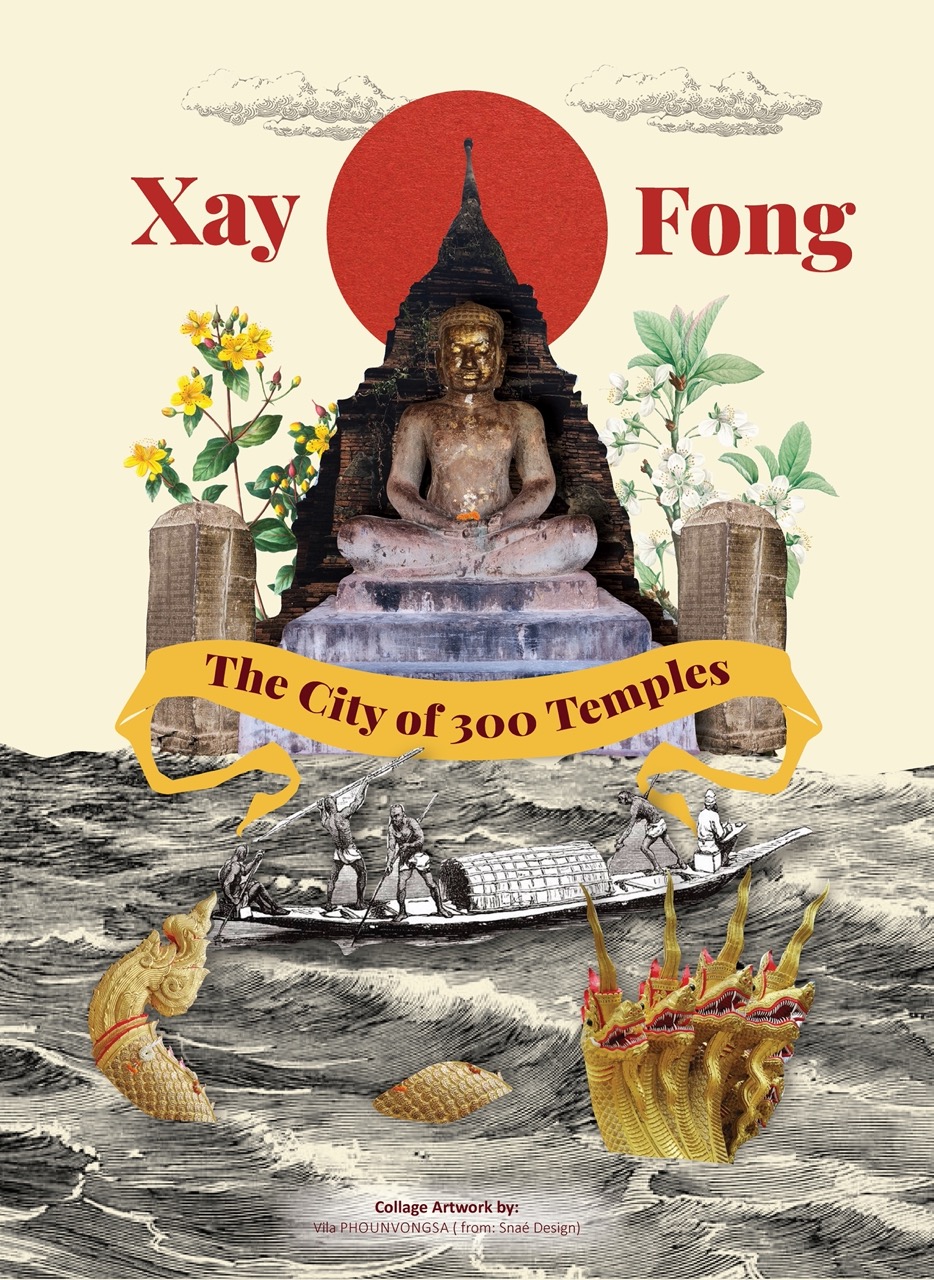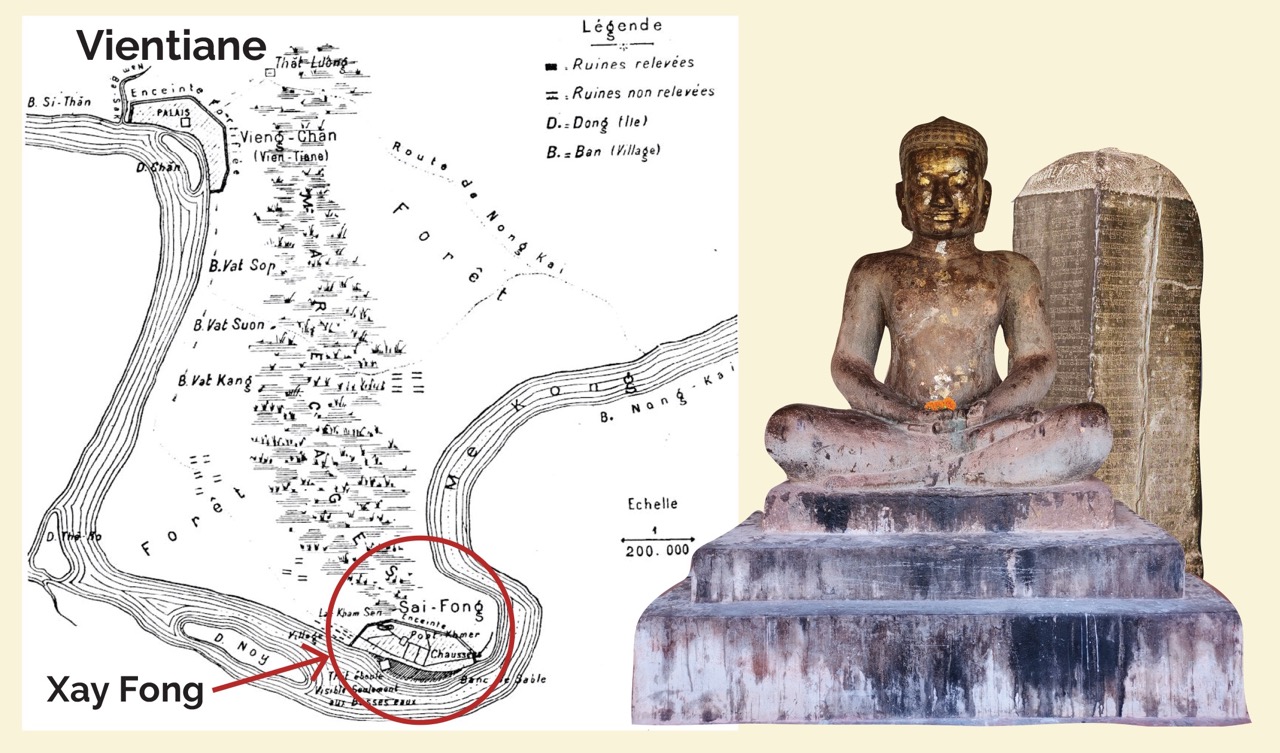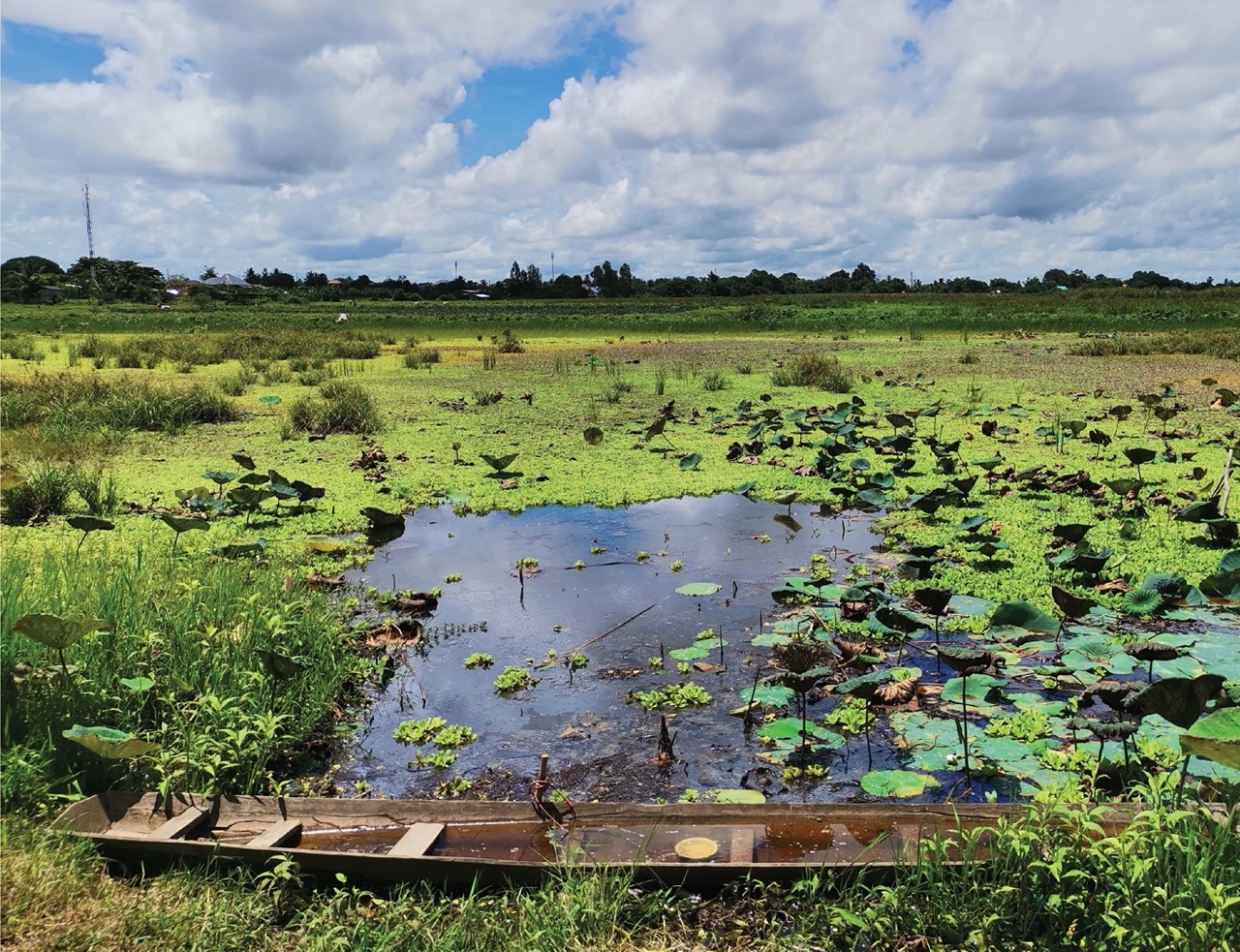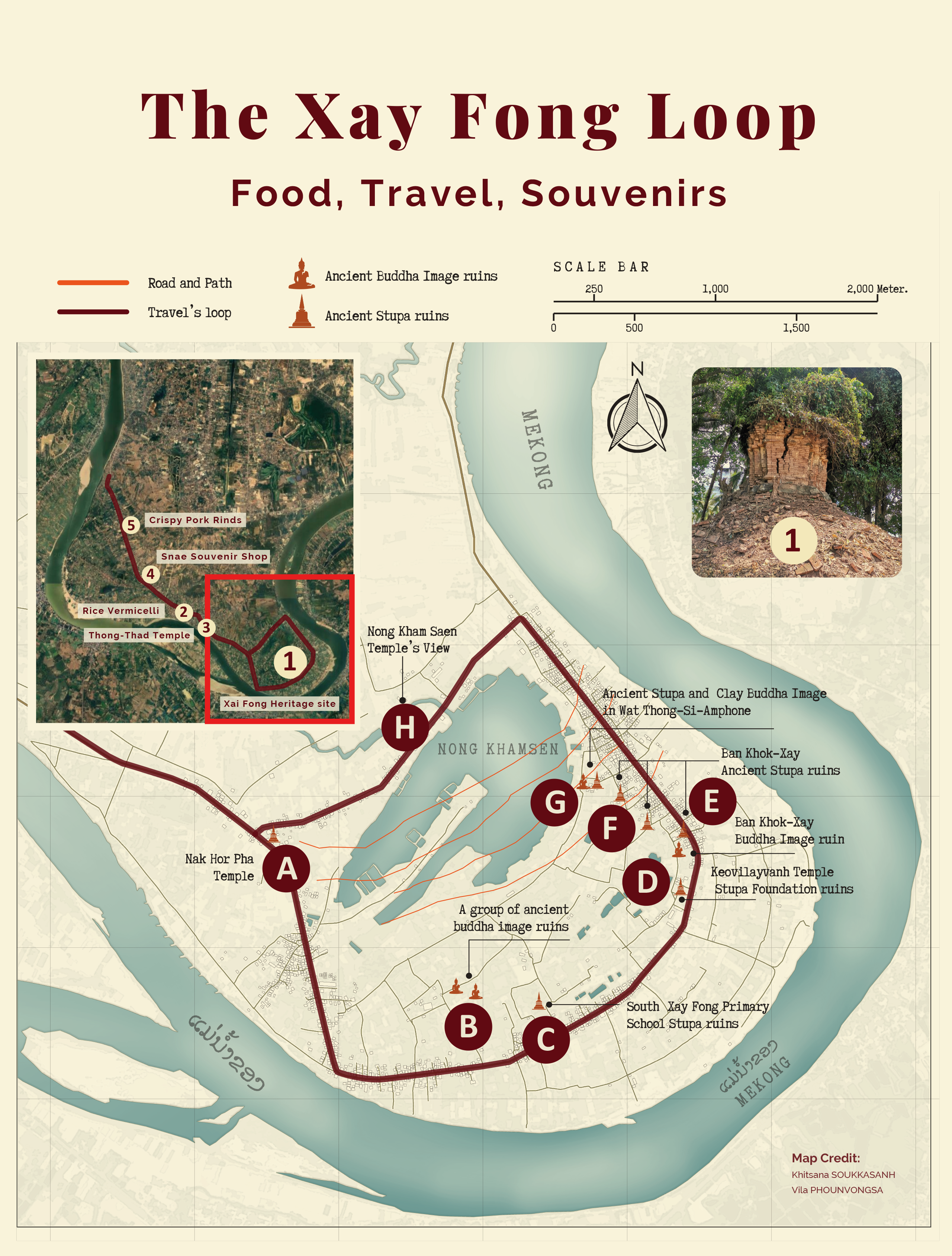 Text by: Vila Phounvongsa ( from: Snaé History)
Text by: Vila Phounvongsa ( from: Snaé History)
Maps and Photos by: Khitsana Soukkasanh, Jason Rolan
Translated by: Jason Rolan
Just 20 kilometers southeast of Vientiane, where the Mekong bends and the rice fields roll out like a green carpet, lies a quiet district with a surprisingly mighty past Xay Fong. At first glance, it may seem like any other riverside village. But look a little closer or take a wrong turn on purposeand you’ll discover ancient ruins hidden in gardens, They call it The City of 300 Temples a place where history, legend, and everyday life intertwine, waiting for curious visitors to wander in.
A Khmer Origin:
Xay Fong’s story begins in the Khmer era, during the reign of King Jayavarman VII (1181–1218 AD), one of Angkor’s most powerful monarchs. At the height of his rule, the Khmer Empire pushed northward into present-day Laos, extending its reach to what is now the Vientiane region.
At that time, Xay Fong was a modest Tai settlement, but around 1186 AD, its strategic riverside location made it an ideal site for a northern administrative hub. The city of Xay Fong was established and became part of the empire’s expanding influence along the Mekong.

Xay Fong in the Lane Xang Era:
Following Jayavarman VII’s death, the Khmer Empire began to weaken. In 1356 AD, Fa Ngum, the founder of the Lane Xang Kingdom, incorporated Vientiane and Xay Fong into his emerging Lao state.
Although the city’s prominence gradually faded, Xay Fong remained relevant until the reign of King Setthathirath (1550–1572), when Vientiane became the new capital of Lane Xang in 1560. By then, Xay Fong had become a quieter outpost, though its riverside location kept it active in trade. Under King Souriyavongsa (1638–1695), Xay Fong functioned as a trading town along with Wiang Khuk, its sister settlement across the river.
Fast-forward to the present day: between 2022 and 2025, surveys in villages like Khok Xay revealed ancient pagodas and Buddha statues nestled in fields and home gardens. A 2009 study by scholar Anna Karlström recorded remains of over 300 temples in the greater Xay Fong region—220 in Xay Fong and 80 in Wiang Khuk—many dating back to the 16th century. This flowering of temple construction earned the era the title Golden Age of Lane Xang.
The Decline of Xay Fong:
The death of King Souriyavongsa in 1695 marked the beginning of Lane Xang’s fragmentation. In 1707, the kingdom split into two: Luang Prabang and Vientiane, with Xay Fong falling under the latter. In 1731, Champasak also broke away, forming a third Lao state.
In 1779, all three kingdoms were conquered by Siam (Thailand). Later, in 1826–1828, King Anouvong of Vientiane launched an ill-fated rebellion against Siamese rule. After his defeat, Vientiane was razed, and much of the population—including those in Xay Fong—was relocated across the Mekong. The once-thriving towns of Xay Fong and Wiang Khuk became quiet rural villages.

What’s in a Name?
The origin of the name “Xay Fong” is uncertain, but two main theories exist:
Theory 1: “Xay” derives from Jaya, the Pali-Sanskrit word for “victory,” and may refer to King Jayavarman VII. “Fong” derives from the Lao word “phong”, meaning “white,” “clean,” or “bright.” Together, the name could mean “glorious victory” or “the glory of Jayavarman.”
Theory 2: “Xay” derives from the Lao word for “sand,” while “Fong” derives from “bubble” or “wave”; together, they form “the city of waving sands.” Local tradition supports this, as Xay Fong has the largest sandbank in Vientiane. Today, the district is officially called “Had Xay Fong,” with Had meaning “beach.” Further research from scholars and future generations may offer clearer insight.
Exploring Xay Fong Today:
Just a 20-minute drive southeast from central Vientiane via Tha Deua Road and the Chinaimo roundabout, Xay Fong offers visitors a peaceful escape filled with cultural and natural attractions.
Where to Eat & Shop:
– Enjoy rice vermicelli with spicy ginger sauce and grilled fish by the Mekong, with stunning river views.
– Pick up crispy pork rinds at Keng Pa Yang, a popular local snack.
– Browse Snaé Shop in Ban Pho Ngan for locally made souvenirs such as T-shirts and bags.
What to See:
– Visit historic 16th-century temples like Thong That, Nong Kham Saen, Pa Ley Lai, and Nak Hor Pha. Local legend claims that Nak Hor Pha Temple once contained a hidden cave connected to Nong Kham Saen Lake, allowing Naga river serpents to travel between the two.
– Discover scattered stupas and Buddha statues made of clay, some intact, others gently fading into the fields they’ve watched over for generations.
Nong Kham Saen: The Legendary Lake
No trip to Xay Fong is complete without a visit to Nong Kham Saen—an 86-hectare natural lake and the last remaining wetland on Vientiane’s outskirts. It’s home to more than 175 species and steeped in legend.
In 1902, French archaeologist G. Maspero documented a haunting local legend: “on full moon nights, a golden boat is said to float above the lake, accompanied by the sound of distant music. Those who see it are doomed to die within the year, cursed by the lake’s spirits”.
The lake’s name, meaning “Hundred Thousand Gold Lake,” comes from another tale. During the construction of That Luang Stupa, devoted villagers loaded rafts with gold to support the project. Upon hearing it had already been completed, they sorrowfully dumped their treasure into the lake. The name Nong Kham Saen has endured ever since.
A Living Past
Today, Xay Fong might not make it into glossy travel brochures, and that’s part of its charm. Its temples are quiet, its legends live in local memory, and its food is full of authentic flavors. Whether you’re a history buff, a spiritual seeker, or just someone with a curiosity for riverside life, Xay Fong rewards those who wander off the map—and into the past.

Give Feedback or Follow:
Snaedesignlao@gmail.com
FB: SNAÉ HISTORY
IG: Snae_Shop



 ລາວ
ລາວ